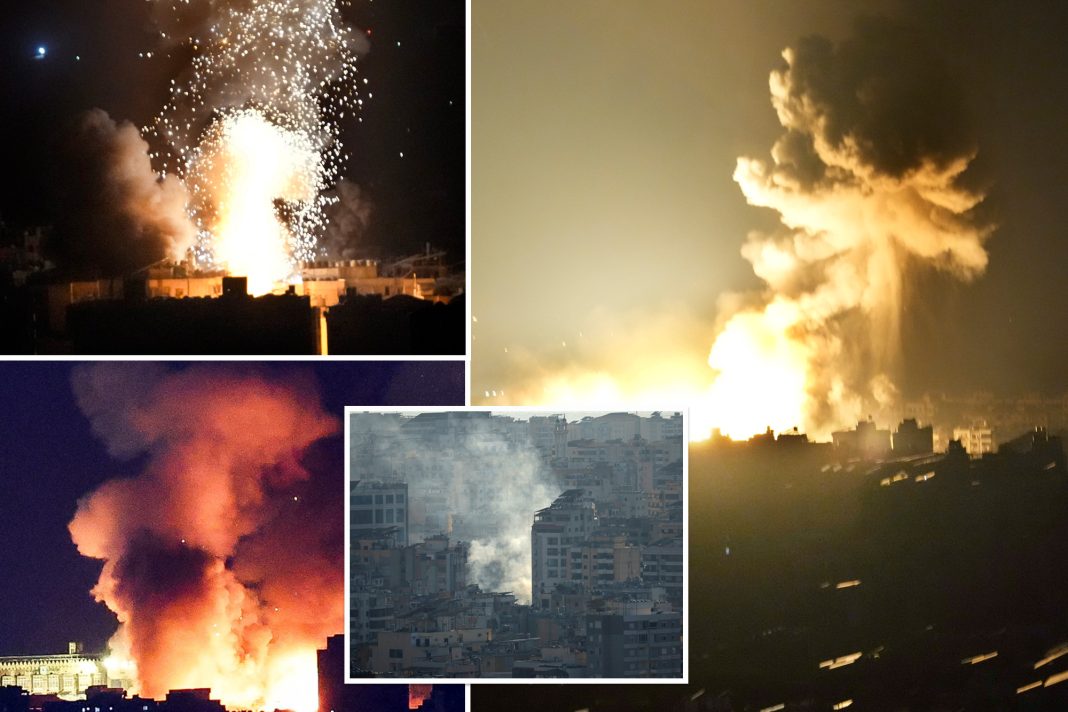In the heart of Beirut, a storm of violence has erupted, reshaping the landscape of the region and igniting fears of a broader conflict. Over the weekend, a series of intense airstrikes rattled the southern suburbs of the city, with eyewitnesses reporting a cacophony of explosions that lit up the night sky with flashes of red and white. For nearly half an hour, the booms reverberated across the city, a stark reminder of the escalating tensions that have come to define Lebanese-Israeli relations.
This latest wave of violence follows a significant escalation in Israeli military action against Hezbollah, the Iran-backed militant group that has long held sway in Lebanon. The situation became particularly dire after the Israeli military announced the killing of Hezbollah’s leader, Sayyed Hassan Nasrallah, in a strike on September 27. The implications of this assassination reverberate through the organization, as speculation swirls around the fate of Hashem Safieddine, Nasrallah’s potential successor, who has been unreachable since an airstrike near Beirut’s international airport. The loss of both leaders would represent a seismic shift for Hezbollah and its Iranian patron, potentially destabilizing the group at a time when it is already facing unprecedented challenges.
Israeli military officials have asserted that their operations in Lebanon have been ramped up to enable the safe return of Israeli citizens displaced by Hezbollah’s rocket fire into northern Israel—fire that has intensified since the outbreak of violence last October. Rear Admiral Daniel Hagari, a spokesperson for the Israeli military, stated that ground operations in southern Lebanon have resulted in the deaths of 440 Hezbollah fighters and the destruction of over 2,000 targets associated with the group. However, Hezbollah has remained tight-lipped about its own casualties, which has led to speculation regarding the true scale of losses on both sides.
Compounding the tragedy, the Israeli strikes have not only targeted military personnel but have also resulted in significant civilian casualties. Lebanese officials claim that hundreds of ordinary citizens have died as a direct result of the assaults, with nearly 1.2 million people—almost a quarter of Lebanon’s population—displaced. The humanitarian crisis is further exacerbated by airstrikes on Palestinian refugee camps, one of which reportedly killed a Hamas member along with his family. Such actions have drawn international condemnation and have sparked protests across major cities worldwide, as public sentiment increasingly turns against the violence affecting civilians in both Lebanon and Gaza.
The anniversary of the October 7 attacks by Hamas on southern Israel looms ominously, serving as a reminder of the cycle of violence that has engulfed the region. In the aftermath of those attacks, which resulted in the deaths of approximately 1,200 people and the kidnapping of about 250, Israel has launched a retaliatory campaign in Gaza that has seen nearly 42,000 Palestinians killed, according to the Gaza health ministry. This extensive military campaign has not only displaced nearly all of Gaza’s 2.3 million residents but has also incited widespread protests and calls for accountability on an international scale.
As the situation unfolds, Iran’s involvement complicates matters further. The Islamic Republic has historically supported both Hezbollah and Hamas and has recently lost key commanders to Israeli strikes. In a show of defiance, Iran launched ballistic missiles at Israel, signaling a potential escalation that could draw in regional powers and worsen the humanitarian crisis.
With oil prices fluctuating amid fears of an Israeli strike on Iranian oil facilities, the geopolitical stakes have never been higher. U.S. President Joe Biden has urged Israel to consider alternative strategies to engaging Iranian infrastructure, highlighting the delicate balance of power in the region. Meanwhile, U.S. military officials, including Army General Michael “Eric” Kurilla, are actively engaging with regional allies, although specific details about their discussions remain undisclosed.
Amidst the chaos, the plight of ordinary Lebanese and Palestinians becomes increasingly urgent. Humanitarian organizations are calling for immediate ceasefires to allow aid to reach those in desperate need. As the world watches, the question remains: will the cycle of violence give way to dialogue and peace, or are we witnessing the dawn of a more expansive conflict that could engulf the region?

